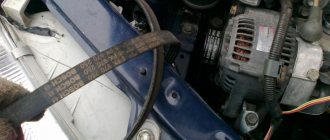Real engine life for Toyota Rav 4 2.0, 2.2, 2.5
Toyota Rav 4 has always positioned itself as a compact crossover, more intended for young people. Actually, the decoding of the RAV abbreviation speaks about the main idea laid down by the manufacturer in the basis of the Japanese car - Recreational Active Vehicle 4 Wheel Drive. Which in translation means – an all-wheel drive vehicle for active recreation. It is the number 4 that indicates that the torque from the engine in this car is transmitted to all four wheels. RAV 4 has been a leader in its segment for several years.
The first generation was released back in 1994. At that time, it was a truly unique car: a 3-door or 5-door layout, independent wheel suspension and a load-bearing body structure. Drivers leading an active lifestyle began to purchase a crossover with great enthusiasm. Over the years, the model has not lost its relevance; on the contrary, it has become even more popular. Today the fourth generation of the model is successfully rolling off the assembly line. And already in 2021, Toyota will begin production of the 5th generation of cars. In this article we will talk about the service life of the Toyota Rav 4 engine of the very first and latest generations.
On the run
Technical characteristics of toyota rav4 xa50
Driving performance Rav4 long is practically no different from short car models. The engine components and classic transmission have been preserved here, so the car behaves familiarly on the road. Due to the long wheelbase, the crossover has become more comfortable, the suspension handles bumps better, and is less likely to bother you with rough bumps. Rav 4 Long is longer, so the ramp angle has been reduced, but this does not have a significant effect on cross-country ability.
The weight of the car has also increased slightly, but since it is recommended to drive the crossover only on hard surfaces, the difference is not felt when driving. The advantages include the ability to drive a car with one wheel suspended.
Photo
In general, the car handles confidently only on asphalt and hard surfaces; the former agility can no longer be achieved from an older Rav 4, but this should be considered an advantage.
Line of power units
Toyota does not hide the fact that each new generation of the model is mainly intended for the young category of drivers aged 25-30 years. A bold statement, one might say that it is even a challenge. However, the Japanese do not go back on their words at all - they are constantly offering new configurations. The line of Rav 4 power units is updated with enviable frequency, as is the design, interior and functionality of the crossover. Initially, the model was equipped with a 2.0-liter 3S-FE engine with a power of 135 horsepower; after some time, a modification of the 3S-GE engine with 178 horsepower appeared. Both engines are combined with a manual or automatic transmission.
Performance characteristics of 3S-FE:
It is worth saying that Toyota has always had not only all-wheel drive, but front-wheel drive modifications that found buyers in North America and Japan. Already with the release of the 2nd generation, the Japanese are offering new power plant options: 2-liter 1AZ-FE, 1AZ-FSE with 150 horsepower, 2.4-liter 2AZ-FE and 2AZ-FSE with a stated power of 160 hp. The two-liter diesel D-4D, which is characterized by good traction, also finds its buyers.
Nominal and actual motor life
A timing chain is used as a timing drive in all crossover gasoline engines. Its service life is noticeably higher than that of other representatives of this car segment - 150 thousand km. Owners of Rav 4 note that after this mark its stretching begins, therefore, it is not recommended to operate the car on the same chain for longer than 150,000 km. With high-quality and timely maintenance, the two-liter naturally aspirated 1AZ-FE engine covers at least 300 thousand km. Cases when this engine traveled 400 and even 500 thousand kilometers are not isolated. There is considerable potential in this modification of the power plant.
Another 2.0-liter naturally aspirated engine, the 3S-FE, has approximately the same resource. This is a fairly reliable power unit, an exact copy of the 2.2-liter engine from the Toyota Camry, but with one difference - it does not have balance shafts. The motor works perfectly on the AI-92, its valves do not suffer in the event of a timing drive break. Along with the drive, the roller and pump are also replaced. The main thing is to respond to the slightest malfunction in a timely manner, as well as replace consumables with high-quality analogues or original parts.
The 2.2-liter AD-FTV turbodiesel is equipped with a belt drive. As a rule, the engine does not cause any special problems during the first 250-280 thousand kilometers. Afterwards, you may need to replace the injectors, which are seriously affected by low-quality fuel. Often, owners have to clean the VRV and EGR vacuum valve ahead of schedule. In some cases, these elements fail prematurely. Replacing them costs 30-50 thousand rubles. Potentially, the 2.2-liter engine is capable of traveling 300 thousand km on Russian roads. To extend the service life of the unit, it is recommended to clean the injectors every 10-15 thousand kilometers.
Ways to find out if repairs are needed
It is impossible to determine the size of the timing belt after a certain mileage without removal, and this procedure itself is not part of the diagnosis. With a chain drive everything is much simpler. In order to determine whether the Rav4 timing chain needs to be replaced, you need to follow simple recommendations.
Using a caliper, measure the distance between the 8 links. The length of the section should not exceed 52.4 mm (2.063 inches). If this value is greater, a replacement must be made.
Using the same tool, the distance between 16 links is determined. It should not exceed 122.6 mm (4.827 inches). To obtain an accurate result, the circuit is measured in both cases in three randomly selected areas.
Use a caliper to measure shoe wear. The maximum wear value should not exceed 1.0 mm (0.039 in).
Wrap the chain around the drive sprocket and measure the diameter. If it is less than 51.6 mm (2.031 inches) there are obvious signs of wear and both elements need to be replaced
Measurements must be carried out in such a way that the measuring device touches the chain rollers.
Reviews from Toyota RAV 4 owners
The 2.5-liter gasoline engine appeared relatively recently. It is not yet possible to say unambiguously what its resource is in practice. However, there is no doubt about the high build quality of the power plant. 2AR-FE has proven itself to be the best since it was installed on the Toyota Camry. It is structurally perfect, has no obvious shortcomings and chronic “sores”. Perhaps the only weakness of the modification is that the 2AR-FE cannot be overhauled. On the other hand, with systematic maintenance, the engine can operate for 400 thousand kilometers. The owner's reviews will provide a comprehensive answer about the service life of the Toyota Rav 4 engine.
Assembly with new parts
The camshaft marks located on the new chain should be aligned with the marks on the camshaft and crankshaft. They are located six links away.
Make sure that the camshaft and crankshaft marks match.
The tensioner pin should face up. Bring the tensioner into working position by pressing the top of the shoe until it stops. To check, use the material at hand (wire) and try to move the pin. If she gave in, then everything is fine.
Check the marks located on the crankshaft pulley and between the camshaft sprockets. You can ignore the marks located on the chain, as they will move. This is due to the fact that there are fewer teeth on the crankshaft sprocket than the number of chain links.
The rest of the assembly of all components and parts is carried out in the reverse order. Take into account the tightening torques.
Source
Toyota Rav 4 engines 4th generation
Toyota Rav 4 4 generations were equipped with the following engines :
2.0 3ZR-FE
A two-liter 3ZR internal combustion engine is used in the 4th generation Toyota Rav 4 in combination with a CVT or manual transmission . Main characteristics of the 2.0 Rav 4 4th generation engine:
The approximate service life of the Rav 4 2.0 3ZR-FE engine is 250 – 300 thousand km , and the factory warranty is given for 100 thousand km or three years . Oil consumption allowed by the manufacturer is limited to 1 liter per 1000 km.
The 2.0 3ZR-FE engine has no global problems. But there are disadvantages:
For reliable operation of the 2.0 3ZR internal combustion engine, use high-quality oil and fuel and change the lubricant in a timely manner.
Engine Toyota Rav 4 2.5 2AR-FE
Toyota Rav 4 with a 2.5 2AR engine in Russia is sold only with all-wheel drive and an automatic transmission . Characteristics of Rav 4 with 2.5 2AR-FE engine:
Specifications
The RAV4 SUV in the XA30 body has the following technical characteristics (specs).
Dimensions
Dimensions of the Toyota RAV 4 (30 body):
- length – 439.5 cm;
- width – 181.5 cm;
- height – 168.5 cm;
- wheelbase – 265 cm;
- ground clearance – 19.1 cm.
After restyling in 2010, the size of the SUV increased to 444.5 cm. The weight of the car is 1462, the total weight is 2070 kg.
Engines
Several types of engines are installed on Toyota RAV4:
- 1AZ-FE – 4-cylinder petrol 2-liter engine, power 152 hp, torque – 194 Nm;
- 2AZ-FE – four-cylinder petrol power unit, V – 2.4 l, power 170 hp, torque – 224 Nm;
- 3ZR-FE - 4-cylinder, 2-liter gasoline unit, power 158 hp, torque - 224 Nm;
- 2GR-FE – 6-cylinder, v-shaped petrol engine, V – 3.5 liters, power 269 hp, torque – 246 Nm;
- 2AD-FTV – 4-cylinder diesel, volume – 2.2 l, power – 175 hp, torque – 400 Nm;
- 2AD-FHV – 4-cylinder diesel power plant, volume – 2.2 l, power – 134 hp, torque – 310 Nm.
The above power plants have a timing chain drive, a service life of more than 300,000 km without major repairs.
Transmission
Until 2010, the 3rd generation crossover was equipped with a 5-speed manual or 4-speed automatic transmission. Later, a CVT was installed instead of an automatic transmission, and the 5-speed manual transmission was replaced with a 6-speed manual transmission.
The automatic transmission and CVT can last from 200,000 to 300,000 km without repair. “Mechanics” are also reliable if you fill in the oil on time. Experts advise using the same lubricant as for the front axle housing.
Suspension and brakes
Toyota RAV 4 III XA 30 has an independent front suspension. The front struts are installed from MacPherson struts, 2 wishbones are designed at the rear, and stiffness stabilizers are added all around.
The chassis has a rigid design; when driving, you can hear the suspension working when driving through minor holes, but the car handles well when cornering. With careful operation, it can last up to 100,000 km without major repairs.
Fuel consumption
On a 3rd generation SUV, fuel consumption varies from 6 to 10 liters per 100 km.
Depends on engine size, power and type of fuel.
Manual control and electrics
Some crossover models with automatic transmission are equipped with a manual control system. It includes an additional lever located near the automatic transmission and a rod that transmits force to the pedals.
The vehicle's ECU is equipped with the SRS safety system. According to the operating manual (manual), in order to protect it from failure or short circuit when repairing electrical elements or replacing fuses, you should turn off the ignition and disconnect the “minus” and then the “plus” from the battery.
Motors Rav 4 3rd generation
Toyota Rav 4 3 generations were equipped with 2.0 gasoline engines of two modifications : 3ZR-FE and 1AZ-FE. The crossover was also aggregated with a petrol 2.4 2AZ.
Engine Rav 4 2.0 1AZ
The two-liter Toyota Rav 4 series 1AZ-FE engine was installed from December 2008 to April 2010 . Parameters of Rav4 2.0 1AZ with four-speed automatic transmission and all-wheel drive :
The 1AZ engine, in comparison with other internal combustion engines, is characterized by high reliability and efficiency. But provided that very good fuel and oil are used.
But typical breakdowns also occur:
Engine 2.4 2AZ
Toyota Rav 4 3rd generation in the 2.4 AT Prestige Long configuration was equipped with a 2AZ-FE power unit in combination with a four-speed automatic transmission . The four-row internal combustion engine has the following characteristics:
With proper maintenance, the resource of the power unit will be more than 300 thousand km .
The manufacturer allows oil consumption up to 1 liter per 1000 km. Among the disadvantages of the ICE 2.4 2AZ are:
Replacing the timing chain
The complexity of the procedure lies in the dismantling of attachments and disassembling the power unit, which takes up to 3 hours. Removing and installing a new drive is quite simple. If all elements need to be replaced, then before performing work, be sure to delve into the timing drive structure of your car. Example: on the same KIA Ceed, the gear is pressed onto the crankshaft under heat, so you cannot dismantle it at home. Then disassembling the engine makes no sense, since it will be possible to replace one chain.
Engine Rav 4 1st generation 2.0 3S-FE
The first generation Toyota Rav 4 was equipped with a 3S-FE internal combustion engine with automatic transmission 4 or manual transmission . The Toyota Rav 4 2.0 engine has the following characteristics:
The Toyota Rav 4 2.0 3S-FE engine is easy to maintain and reliable. Among the problems, one can note an increase in oil consumption after two hundred thousand kilometers. The timing belt drive rotates the pump and oil pump.
There are no hydraulic compensators, so check valve clearances regularly.
Salon
Toyota rav4 2nd restyling 2010, jeep/suv 5 doors, 3rd generation, xa30 (05.2010 - 01.2013) - technical characteristics and equipment
But if you look closely at the interior, there are not so many things that bring tactile pleasure. The rubberized pucks for controlling the climate, radio and driving modes look unusual and are pleasant to the touch.
The steering wheel of the new Rav 4 is ordinary, the buttons on it are simple, some are too small. Nothing remarkable.
The chairs are characteristically shapeless for Toyota and are uncomfortable to sit in.
The instrument panel consists of a display (not in all trim levels of the new Rav 4) with a large semicircular speedometer, and inside it the on-board computer data is displayed. They are inconvenient to read, there is a lot of information, and the font is small. Mechanical tachometer, fuel level and coolant temperature gauges are located on the sides of the display.
The multimedia system is not the strong point of the new Toyotas. The picture resolution is depressing by modern standards, the graphics are poorly designed, and the menu is not always clear. And the view from the all-round camera is frankly bad. The angle and image quality are terrible. Black elements that are not drawn indicate poor quality workmanship.
previous generation interior from above
Trunk
Speaking about the trunk of the new Toyota Rav 4 crossover, we note that the electric drive is still very slow. But the compartment is spacious, the hard plastic floor is covered with fabric, and everything else is made of plain black plastic, which is not very good considering the price.











